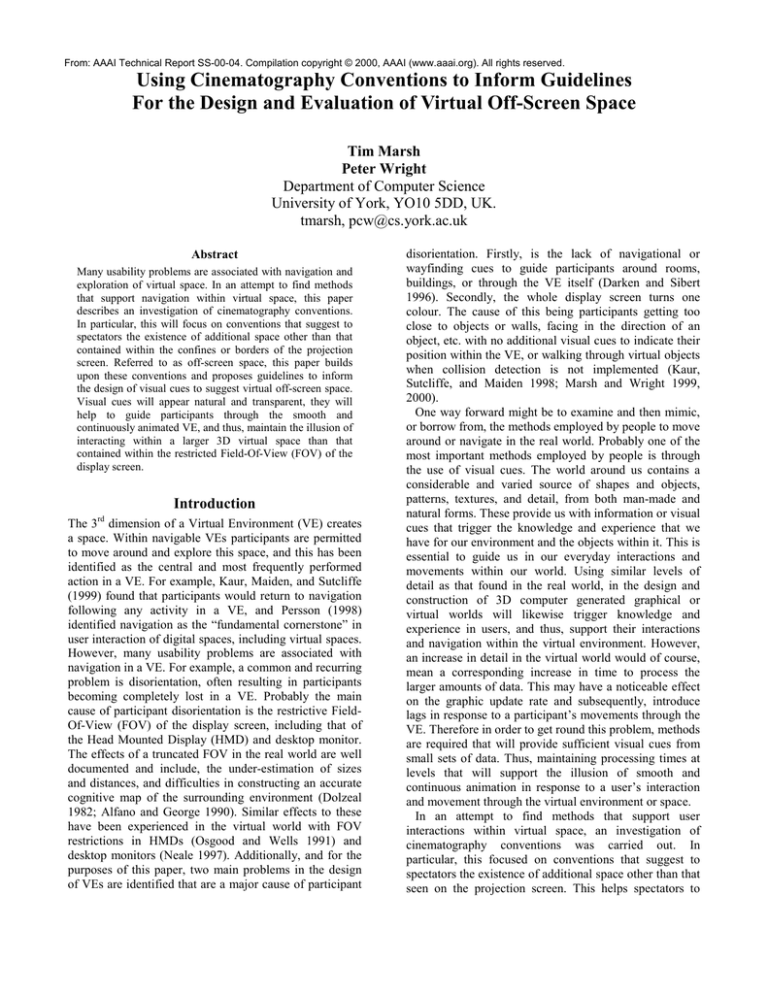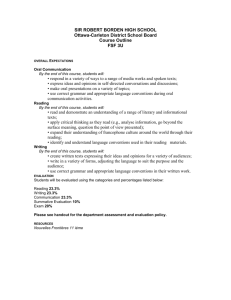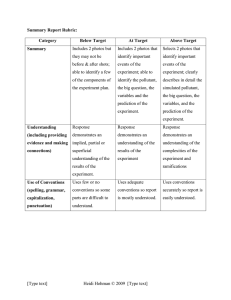
From: AAAI Technical Report SS-00-04. Compilation copyright © 2000, AAAI (www.aaai.org). All rights reserved.
Using Cinematography Conventions to Inform Guidelines
For the Design and Evaluation of Virtual Off-Screen Space
Tim Marsh
Peter Wright
Department of Computer Science
University of York, YO10 5DD, UK.
tmarsh, pcw@cs.york.ac.uk
Abstract
Many usability problems are associated with navigation and
exploration of virtual space. In an attempt to find methods
that support navigation within virtual space, this paper
describes an investigation of cinematography conventions.
In particular, this will focus on conventions that suggest to
spectators the existence of additional space other than that
contained within the confines or borders of the projection
screen. Referred to as off-screen space, this paper builds
upon these conventions and proposes guidelines to inform
the design of visual cues to suggest virtual off-screen space.
Visual cues will appear natural and transparent, they will
help to guide participants through the smooth and
continuously animated VE, and thus, maintain the illusion of
interacting within a larger 3D virtual space than that
contained within the restricted Field-Of-View (FOV) of the
display screen.
Introduction
rd
The 3 dimension of a Virtual Environment (VE) creates
a space. Within navigable VEs participants are permitted
to move around and explore this space, and this has been
identified as the central and most frequently performed
action in a VE. For example, Kaur, Maiden, and Sutcliffe
(1999) found that participants would return to navigation
following any activity in a VE, and Persson (1998)
identified navigation as the “fundamental cornerstone” in
user interaction of digital spaces, including virtual spaces.
However, many usability problems are associated with
navigation in a VE. For example, a common and recurring
problem is disorientation, often resulting in participants
becoming completely lost in a VE. Probably the main
cause of participant disorientation is the restrictive FieldOf-View (FOV) of the display screen, including that of
the Head Mounted Display (HMD) and desktop monitor.
The effects of a truncated FOV in the real world are well
documented and include, the under-estimation of sizes
and distances, and difficulties in constructing an accurate
cognitive map of the surrounding environment (Dolzeal
1982; Alfano and George 1990). Similar effects to these
have been experienced in the virtual world with FOV
restrictions in HMDs (Osgood and Wells 1991) and
desktop monitors (Neale 1997). Additionally, and for the
purposes of this paper, two main problems in the design
of VEs are identified that are a major cause of participant
disorientation. Firstly, is the lack of navigational or
wayfinding cues to guide participants around rooms,
buildings, or through the VE itself (Darken and Sibert
1996). Secondly, the whole display screen turns one
colour. The cause of this being participants getting too
close to objects or walls, facing in the direction of an
object, etc. with no additional visual cues to indicate their
position within the VE, or walking through virtual objects
when collision detection is not implemented (Kaur,
Sutcliffe, and Maiden 1998; Marsh and Wright 1999,
2000).
One way forward might be to examine and then mimic,
or borrow from, the methods employed by people to move
around or navigate in the real world. Probably one of the
most important methods employed by people is through
the use of visual cues. The world around us contains a
considerable and varied source of shapes and objects,
patterns, textures, and detail, from both man-made and
natural forms. These provide us with information or visual
cues that trigger the knowledge and experience that we
have for our environment and the objects within it. This is
essential to guide us in our everyday interactions and
movements within our world. Using similar levels of
detail as that found in the real world, in the design and
construction of 3D computer generated graphical or
virtual worlds will likewise trigger knowledge and
experience in users, and thus, support their interactions
and navigation within the virtual environment. However,
an increase in detail in the virtual world would of course,
mean a corresponding increase in time to process the
larger amounts of data. This may have a noticeable effect
on the graphic update rate and subsequently, introduce
lags in response to a participant’s movements through the
VE. Therefore in order to get round this problem, methods
are required that will provide sufficient visual cues from
small sets of data. Thus, maintaining processing times at
levels that will support the illusion of smooth and
continuous animation in response to a user’s interaction
and movement through the virtual environment or space.
In an attempt to find methods that support user
interactions within virtual space, an investigation of
cinematography conventions was carried out. In
particular, this focused on conventions that suggest to
spectators the existence of additional space other than that
seen on the projection screen. This helps spectators to
construct off-screen space implying that additional space
and action exists beyond that shown within the confines
or boundaries of the screen. Building on these
conventions, guidelines are proposed that will inform the
design and evaluation of virtual environments to suggest
off-screen space to users. This will imply the potential for
further action within a virtual space, provide visual clues
that will help to guide the user through the virtual space,
and will thus, overcome some of the usability problems
associated with navigation within virtual space.
Additionally, it is anticipated that the guidelines and the
VR enabling technology to support the guidelines will
appear transparent to the user, thus, re-enforcing the
illusion of interacting within a virtual space, and possibly
having a positive effect on a user’s experience.
Background
Prior to the development of cinematography conventions
to construct and/or articulate time and space, films were
shot with the camera fixed in one position, usually
mounted on a tripod, and the narrative took place within
this fixed frame captured by the camera. That is, the
actors, props, objects, and scene, and the spatial relations
between them are explicitly represented within the still
frame. Therefore, they are unambiguous to the viewer.
This style is referred to as the long-take style. It
maintained the illusion of “theatrical” or real space, in
which, the viewer has “an immediate and constant sense
of orientation” (Burch 1983). The development of editing
techniques provided cinematography with a way to escape
from the restrictions of a still long-take style, and
introduced a system whereby the space of a scene can be
altered from shot-to-shot to create an artificial or
“cinematic space” (Burch 1983). In “cinematic space”,
shots are taken from different camera angles or even
different locations (more than likely, these have been shot
at different times), and present fragments of the total
space to the viewer (Kepley 1983). The fragmented shots
are edited together to create the overall space of the scene,
and these appear natural and transparent to the viewer;
that is, they add up (Kepley 1983).
Conventions to Articulate Time and Space
Cinematic conventions to represent time and space arose
in order to communicate experience and to serve as
syntactic elements in the construction of meaning (Laurel,
Strickland, and Tow 1994). Referred to by many names
including, “classical cinema” and “invisible style”, to a
large extent this style emerged from Hollywood in the
1910’s, 20’s and 30’s and eventually came to dominate
commercial narrative cinema (Kepley 1983). The main
reason for the style’s adoption is as Laurel et al. (1994)
explain, that it was successful in forming a language that
supports the creation of films of increasing complexity
and power. Film unfolds in time and space (Burch 1983).
To a large extent, the conventions to represent time and
space in cinema are inseparable. They are intertwined. An
editing technique to represent or articulate one of these,
may also have an effect on the other. Take for example,
an edit which is used to represent a transition in space
between scenes in different locations, using say a wipe,
fade or dissolve. This may also infer a temporal transition,
to denote, going back in time or flashbacks, the passing of
time or that time has elapsed, or traveling forward in time
or flash-forwards.
In contrast, virtual environments or spaces unfold in real
or continuous time in response to particiapants’
interaction within the virtual space. That is, instead of
passively receiving information or narrative as a spectator
of film, in VR your contribution determines the outcome.
Participants in a virtual environment create their own
journey or narrative through constant time and within
virtual space. Or as Laurel et al. (1994) state, “the
experience of VR hinges on human action and the
environments response”, and “in VR one is not done unto
but doing”. The additional interactive component of VR is
what sets it apart from cinema and this is shown simply
and effectively in the hierarchical Framework of VR
developed by Marsh et al. (1998). This interaction occurs
in real time, and thus, it is the interactive component that
dictates the unfolding of virtual space in real or
continuous time. As a result, it is difficult to envisage how
edits that represent temporal transitions can be applied in
the design of VEs. That is, can VE design make use of
conventions to suggest flashbacks or the passing of time?
Future developments may well devise ways in which
temporal transitions will be applied in the design of
virtual environments, and these may feel natural and
transparent to the user. Although, this is an area of further
research, and its outcome remains to be seen.
Additionally, it is difficult to envisage how to apply the
same on-screen editing techniques (including: wipes,
fades or dissolves) to support transitions in virtual space.
Although, it is easier to imagine the use of these edits as
jump-cuts. That is, to relocate or teleport a user from one
location to another location in virtual space. Pausch and
Burnette (1995) proposed a similar technique that allows
a user to view the virtual environment or world in
miniature, select a location within that environment, and
then be teleported to that new location. The central
concern with this, and similar techniques to that of
teleportation, is that of user distortion. Thus the work
presented here will focus on conventions that support the
smooth and continuous animation of a participant’s
interactions within and through a virtual space, and will
therefore attempt to alleviate user distortion.
Design of Virtual Off-Screen Space
The work described so far has focused on conventions for
the construction and articulation of space that is contained
within the pictures that are framed by the borders of the
projection screen. This is referred to as on-screen space.
There is however, another kind of space in
story unfolds, the audience learns that the door to the left
of the set leads to the kitchen and the door to the right
leads to the back yard. Although the spaces contained offstage are purely imaginary, the audience will however,
construct a cognitive map of the off-stage space and this
is essential for the development and understanding of the
theatrical production. Implementation of exit and entry
points in VEs can be achieved by the use of graphical
models or representations of: doors, paths, roads, etc.,
Their existence in the VE will trigger a participant’s
knowledge and experience. They imply that by taking this
pathway a participant can reach other spaces that are not
contained within the confines of the display screen. An
example of a typical guideline for exit and entry points is
shown in table 1 and this can be used to inform the design
and the evaluation of virtual environments. Exit and entry
points such as paths and roads are a special case or subgroup of partially out of the frame. See description below.
This is because only part or a section is shown on-screen.
The second of these is points of view. In
cinematography this convention is used frequently. Offscreen space is suggested to the spectator by a character
on-screen looking somewhere off-screen, for example,
either to an object, location, or talking to another person
located off-screen. Persson (1998) suggests using this in
VR by employing an avatar to look at something that is
not contained within on-screen space and so suggest that
space exists off-screen. A typical guideline for this might
be as contained in table 1. The use of this guideline will
be especially useful in multi-user environments, such as,
collaborative VEs and in video teleconferencing.
cinematography, the space that exists outside that of the
projection screen and is referred to as off-screen space.
Off-screen space is more complex than on-screen space
and includes everything out of the frame, or not shown on
the screen. In most part, this is purely imaginary. Offscreen space is divided into 6 segments. The 1st to 4th
segments are determined by the edges of the screen. The
5th segment is the area behind the camera, and the 6th is
the space that exists behind the set, the outer limit is
beyond the horizon (Burch 1983). Cinematography
conventions have been developed that suggest to
spectators the existence of off-screen space. The purpose
of this, is to support the fragmented shots of the ‘classical
Hollywood’ style, and so imply that additional space and
action exists beyond that which is shown within the
confines or boundaries of the screen. There are three main
conventions used to imply off-screen
space in
cinematography: exit and entry points, points-of-view, and
partially out of the frame (Burch 1983). These
conventions provide a means to inform the construction of
off-screen space in VEs in present and continuous time,
and this is consistent with the smooth and continuously
moving animation within a VE. Building on these
conventions, guidelines are proposed to inform the design
and evaluation of virtual off-screen space.
The first of these is exit and entry points. Refer to table
1. In cinema, characters exiting or entering through one of
these points will suggest to the spectator that there is
space off-screen that leads to another area not shown onscreen. Theatre uses similar techniques to help audiences
construct off-stage space that is additional to that which is
seen on-stage. For example, as a play progresses and the
cinematography
cinema
virtual reality
guideline
conventions
exit and entry points
points of view
partially out of the frame
Table 1.
•
character passing through
door / corridor
•
character moving out of
the frame
•
up / down stairs or in a
caged lift
•
talking to someone offscreen
•
looking off-screen
•
sticking part of body offscreen
•
object partly on-screen
•
doors, hallways, paths,
windows, roads, etc.
•
wherever possible, it must
be clear to the user that
there exists the option to
exit the area contained
within the confines of the
display screen (HMD /
monitor)
•
avatar gazing at / talking
to, something / somebody
off-screen
•
where applicable, avatars
should have the ability to
look to space contained
off-screen
•
familiar object shown
partly in frame (HMD,
display monitor)
•
the placement of objects in
the virtual environment
should be such that there
is always more than one
object partially in the
user’s FOV
Guidelines for the design and evaluation of virtual off-screen space
Finally, the third is partially out of the frame. In
cinematography, a character or object is framed in such a
way that some part of a character’s body or a part or
section of an object protrudes out of the frame to infer the
space out of the screen. For example, a character sticking
their head off-screen, say through a door or window to
find out what is going on in the space we cannot see. Or
an object that is only partly seen on-screen constantly
reminds spectators of the off-screen space where the rest
of the object is contained. In the design of VEs,
techniques such as this could be employed by having only
part of a familiar object shown on a display screen. This
object’s part is recognized as being only a section of the
whole object and thus imply that the rest of object is in
off-screen space. Persson (1998) suggests using a similar
technique to trigger users’ recognition of familiar objects.
For example, using part of a human body as the
background for a web page to suggest the potential to
scroll to view more of the human body in off-screen
space. Hence, implying that there is a larger web page
than that seen through the restricted FOV of the display
screen. An example of a typical guideline for partially out
of the frame is given in table 1, and the design of a virtual
room using this guideline in shown in figure 1 below.
Figures 2 to 5 show a participant’s FOV whilst panning
around the virtual room at eye-level. These guidelines
attempt to increase a participant’s awareness of off-screen
by continually having a partial object within the FOV, as
shown.
Further Work
Future work will be concerned with guidelines to inform
the design and evaluation of virtual off-screen space. For
present purposes, this work is concerned with single user
virtual environments and therefore, will concentrate on
two of the three conventions: exit and entry points, and
partially out of the frame, and investigate the interplay
between the two. Studies are planned that will test the
effectiveness of these guidelines in the design and the
evaluation of virtual off-screen space. It is expected that
this will be an empirical study of two groups. One group
will be required to carry out tasks in a virtual environment
with the design guidelines implemented and the other in
the same virtual environment without the guidelines
implemented. A comparison of the two results will then
be performed. It is anticipated that the use of guidelines in
the design will reduce the number of usability problems.
Additionally, it is expected that the guidelines will appear
natural and transparent to the participant, thus, reenforcing the illusion of interacting within a virtual space,
and possibly having a positive effect on a user’s
experience.
Acknowledgements
Thanks to Duff Hendrickson. This work was carried out
in-part at the Human Interface Technology Laboratory
(HITL), University of Washington, Seattle, WA. Funded
by, UK EPSRC INQUISITIVE (Grant GR/L53199).
References
Alfano, P. L. and George, M. F. 1990. Restricting the
field of view: Perceptual and performance effects.
Perceptual and Motor Skills, 70, 35-40.
Burch, N. 1983. Theory of Film Practice, London:
Praeger Publishers Inc.
Figure 1. Virtual room designed using the guideline for
partially out of the frame
Darken, R. P., and Sibert, J. L. 1996. Wayfinding
Strategies and Behaviours in Large Virtual Worlds, In
Proceedings of Human Factors in Computing Systems
CHI, ACM Press.
Dolzeal, H. 1982. Living in a World Transformed –
Perceptual and Performatory Adaptation to Visual
Distortion, Academic Press Inc., New York.
Kaur, K., Sutcliffe, A., and Maiden, N. 1998. Improving
Interaction with Virtual Environments, In Advanced 3D
Virtual Interfaces, The 3D Interface For The Information
Worker (IEE), London.
Figures 2 to 5. Participant’s FOV whilst panning the
virtual room
Kaur, K., Maiden, N., and Sutcliffe, A. 1999. Interacting
with virtual environments an evaluation model of
interaction, Interacting with Computers, Vol. 11, No. 4,
Elsevier.
Kepley, V. Jr. 1983. Spatial Articulation in the Classical
Cinema: A Scene from His Girl Friday, (Notes From)
Wide Angle, vol. 3.
Laurel, B., Strickland R., and Tow R. 1994. Placeholder:
Landscape and Narrative in Virtual Environments,
Computer Graphics, vol. 28, no. 2, ACM SIGGRAPH.
Marsh, T., Wright, P., Smith, S., and Duke, D. 1998. A
Shared Framework of Virtual Reality, In Proceedings of
5th UKVRSIG.
Marsh, T., and Wright, P. 1999. Co-operative Evaluation
of a Desktop Virtual Reality System, Workshop on User
Centered Design and Implementation of Virtual
Environments, King’s Manor, University of York.
Marsh, T., and Wright, P. 2000. Usability and Spatial
Evaluation of a Stereoscopic Head Mounted Display
Virtual Reality System. Forthcoming.
Neale, D.C., 1997. Factors Influencing Spatial Awareness
and Orientation in Desktop Virtual Environments. In
Proceedings of the Human Factors and Ergonomics
Society 41st Annual Meeting, Albuquerque: Human
Factors and Ergonomic Society.
Osgood, R. K., and Wells, M. J., 1991. The effect of fieldof-view size on performance of a simulated air-to-ground
night attack. In Proceedings of Helmet Mounted Displays
and Night Vision Goggles, Pensacola, FL.
Pausch, R., Burnette, T., 1995. Navigation and
Locomotion in Virtual Worlds via Flight into Hand-Held
Miniatures, In Proceedings of SIGGRAPH, ACM.
Persson, P. 1998. A Comparative Study of Digital and
Cinematic Space with Special Focus on Navigation, In
Proceedings of Ninth European Conference on Cognition
Ergonomics: Cognition and Co-operation.






